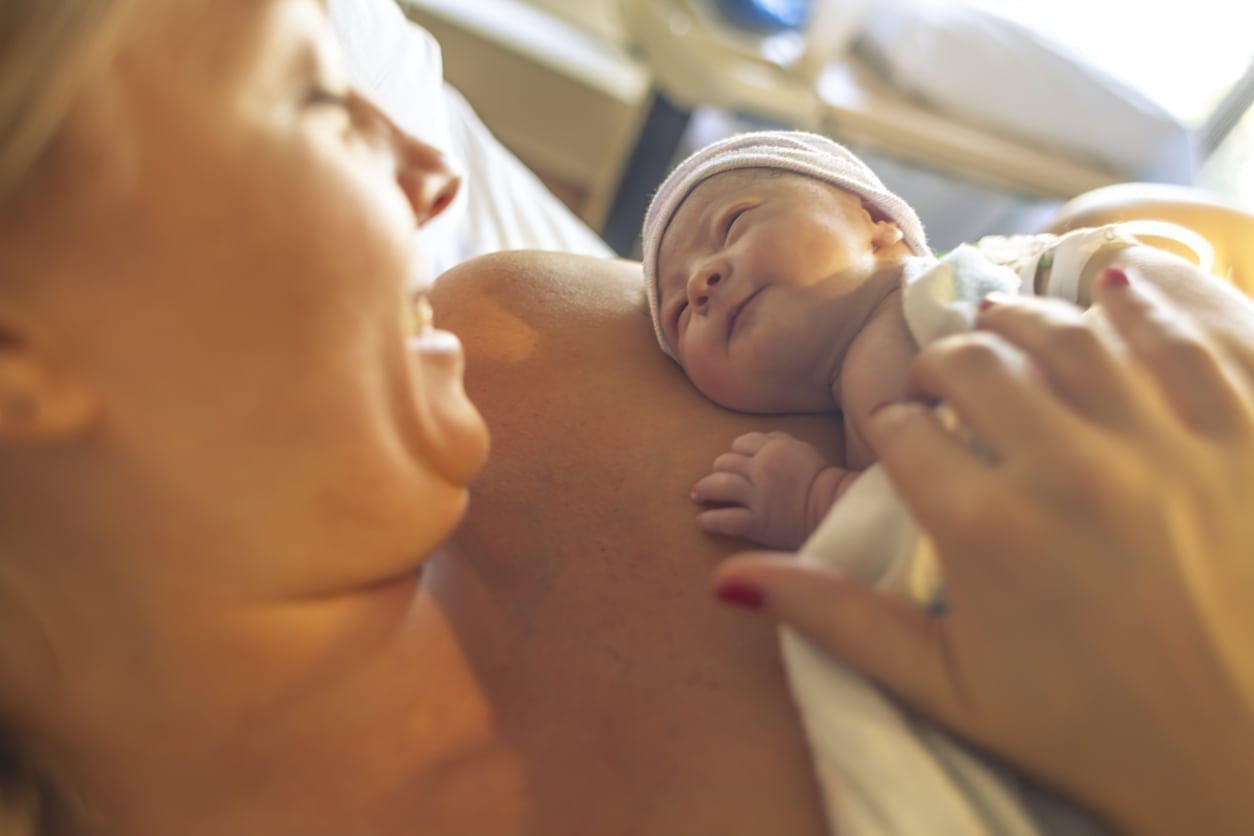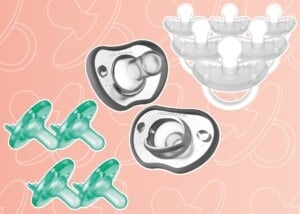The newborn baby smell… It’s addicting. Ask almost every new mom (or any woman), and she will tell you the same thing. As soon as you see and smell your little one, all you want to do is cuddle them close and breathe them in. *sigh* It’s normal to have that instinct to bring baby close. A recent study found that a newborn’s smell is as addictive as drugs or food.1 Not surprising, but isn’t that crazy?! And did you know that there are many benefits to bringing baby close? Right after giving birth is the best and most crucial time to have skin-to-skin contact with a newborn baby.
Immediately bringing baby up to the mother’s chest and not having a blanket or clothing between the two is beneficial and something every woman should do. This is called skin-to-skin or kangaroo care. Skin-to-skin time can wait if mom or baby is distressed or needs immediate medical attention. If everyone is doing well and is healthy, there is no reason every woman shouldn’t do skin-to-skin. Checking the baby’s weight and doing their measurements can wait. Multiple studies have proved that skin-to-skin should be done at least an hour after birth.2 And if you want to know why you should do it, besides the newborn smell, here are some benefits of skin-to-skin that prove it’s the best thing to do with your newborn.
1. Keeps Baby Warm, Regulates Their Breathing & Keeps Their Blood Sugar Levels Higher
Did you know that your breasts and abdomen can stabilize your baby’s vitals and keep your baby warm better than a baby warmer/incubator? It’s true! Mothers can naturally adjust “the warmth of their breasts to keep their infants at the optimal temperature,” says Midwifery Today. “Maternal breast temperature can rise rapidly, then fall off as baby is warmed. As the baby starts to cool, the breasts heat up again—as much as 2 degrees C in two minutes!” That’s 3.6 degrees Fahrenheit. Isn’t that incredible?!
Also, because newborn babies’ systems are immature, they can sometimes temporarily stop breathing and/or have slow heart rates. While most of the time, they can begin breathing again on their own, the cues you provide by breathing and your heart beating are what their little bodies can learn from more quickly to organize essential systems. As you breathe, the baby will synchronize their breath and heartbeat to yours. And there isn’t a baby warmer in the world that can do that.
2. Improves Chances of Breastfeeding
A considerable benefit of skin-to-skin is that babies are more likely to nurse sooner and longer. You don’t even have to force baby to your breast when doing skin-to-skin. Have you heard of the breast crawl? Your baby can find your breasts and latch themself on. (Sometimes, they will need a little assistance if you had a medicated birth or if they have lip-tie or tongue-tie.) The sooner you establish breastfeeding, the faster it can help establish mama’s milk supply.
“In a study of 21 babies after vaginal birth, three researchers divided them into two groups. One group was laid skin-to-skin on the mother’s body, examined briefly, then returned to skin-to-skin contact for two hours. The other group was shown to the mother, examined, swaddled with baby’s hands free, and then returned to the mother. The swaddled group showed delayed feeding behaviors, suckled less competently at their first breastfeeding, and established effective breastfeeding later.”3
3. Enhances Bonding
Many professionals in the birthing industry, including myself, call the first hour after birth ‘The Golden Hour.’ This is when “mother and child are best primed to form an intense chemical connection with each other,” writes Patty Onderko, a mother of twin boys. What makes ‘The Golden Hour’ so “golden” is the hormone oxytocin – the “love hormone.” This helps the uterus contract during labor, plays a critical role in bonding, and helps with lactation. Patty wrote this article after having a cesarean, resulting in just a brief moment of contact after her boys arrived. I love that she says no one factor makes or breaks us as mothers. I could not agree more. This is not to say women who have cesareans cannot practice skin-to-skin/kangaroo care. They often can!
4. Helps Baby Cry Less
A review of 34 randomized studies involving 2177 mothers and their babies showed that babies exposed to skin-to-skin contact interacted more with their mothers and cried less than babies receiving usual hospital care.4 This can lead to lower stress levels for a new mother who is otherwise unsure how to calm her crying infant.” Another reason why I highly encourage skin-to-skin and, not only that, babywearing. Dads can do it, too!
5. Makes Baby Sleep Better
The same study from the journal Pediatrics said, “Skin-to-skin contact helps infants fall asleep more easily and also sleep for a longer period. This allows the new mother to get more rest and reduce stress levels.”4 Huge! This is a significant reason mothers should be resting with their babies on their chests doing skin-to-skin so they can both sleep more soundly.
6. Improves Baby’s Gut Health & Immunity
Skin-to-skin also helps the baby’s digestive system mature. A study reports that the contact “stimulates the vagal nerve, causing increased growth in the size of the villi in the newborn gut, which provides a larger surface area for the absorption of nutrition.” There is also “less chance of infection because babies given kangaroo mother care become colonized with the bacteria on their mother’s skin. This causes her milk to produce antibodies in response and makes it specifically protective against those bacteria. In other words, it strengthens their immune system. This is by far one of the main kangaroo care benefits in both poor and wealthy countries alike.” – Nurture Through Touch.5 A great thing to do if your baby is experiencing colic since this is sometimes linked to gut/digestive issues.
7. Reduced Postpartum Depression
So many things can cause women to have postpartum depression. New research suggests that skin-to-skin contact immediately following birth may reduce postpartum depression in moms.6 Holding, kissing, snuggling, smelling, and breastfeeding your baby right after birth stimulate intricate hormonal patterns within the mother that reinforce mothering behaviors and feelings of well-being. Some experts believe that if she cannot experience those things, the mother’s body interprets this as something wrong with the birth and/or her baby. This can induce a stress/grief response that, in some cases, may create feelings of anxiety or depression.
According to a study in the Journal of Obstetric, Gynecological, and Neonatal Nursing, “skin-to-skin contact between the mother and baby may be an alternative therapy for mothers trying to avoid taking medication. The study reveals that new mothers who had six hours of skin-to-skin contact during the first week, followed by at least two hours during the next month, reported fewer depressive symptoms. Saliva samples confirmed lower cortisol levels, a marker of stress, than their counterparts. For a baby, skin-to-skin contact helps fulfill the need for human contact and promotes bonding. The touching releases the hormone oxytocin in the mother, which encourages infant/mother attachment and increases the feeling of well-being and relaxation.”7
What’s great about skin-to-skin is that it is free and has no side effects. “Unlike other interventions to reduce depressive symptoms in the postpartum months, skin-to-skin care is easy to use, readily accessible, cost-effective, and without adverse effects,” said AWHONN’s Chief Executive Officer, Karen Peddicord, Ph.D., RN. “Therefore, women’s health professionals can encourage their patients to practice mother/infant skin-to-skin care as an intervention strategy to lessen depressive symptoms and anxiety while improving maternal mood.”
Who Can Do Skin-To-Skin?
“Skin-to-skin with baby is good for all types of births, assuming your baby is stable, as most full-term babies are at birth. Even after a cesarean birth (C-section), mom can hold baby skin to skin or dad if mom is unavailable. Skin-to-skin care for preterm babies is also important, and many NICUs will direct you in how to use skin-to-skin care to help stabilize your new baby,” says childbirth educator Robin Weiss.
If you want to be skin-to-skin, let your practitioners know before you go into labor and have your baby!
To recap, skin-to-skin contact immediately after birth, which lasts for at least an hour (and should continue for as many hours as possible throughout the day and night for the first few weeks), has the following positive effects. The baby:
- Maintains their body temperature at normal levels better even than in an incubator
- Maintains their heart rate, respiratory rate, and blood pressure normal
- Has higher blood sugar
- Will indicate to their mother when they are ready to feed
- Is more likely to latch on well
- Is more likely to breastfeed exclusively and breastfeed longer
- Bonds better with the mother and father
- Is less likely to cry
- Sleeps better and longer
- Has better gut health and stronger immunity
- Being skin-to-skin helps reduce the chances of the mother having postpartum depression.
Who wouldn’t want their baby to have all of these benefits? And it’s completely free! Did you do skin-to-skin with your newborn?














